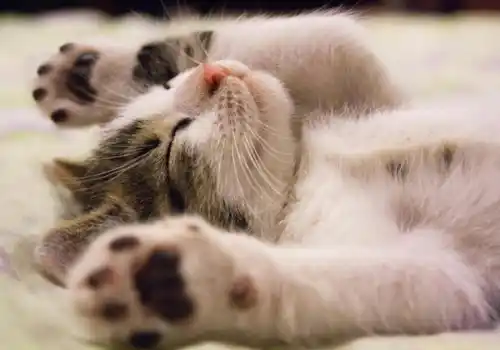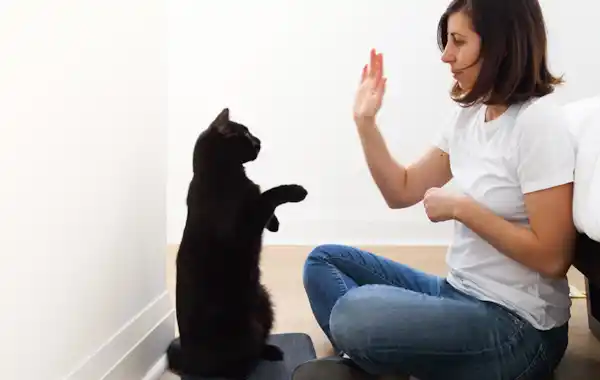Ever wondered if can teach your cat tricks? We meet the behaviourist who says it is possible and is good for your cat.
Does your cat wake you up in the middle of the night? Steal socks? Shred loo rolls? Climb the curtains? Or perhaps, you have the opposite problem and share your home with a scaredy cat who cowers under the sofa and trembles through trips to the vet’s.
If so, Julie Posluns, animal behaviourist and founder of the Instagram famous Cat School, believes that teaching your cat fun and practical skills is a great way to strengthen your bond. She claims that a few minutes of training each day could help you to overcome some of the most common behavioural problems. As an added bonus, she says your cat will be happier and more active — and training is a fun way to bond with your cat.
“There are so many benefits to cat training,” says Julie, who is based in Toronto. “It’s a great way to teach your cat life skills; you can get them go into a carrier, get them used to brushing, or get them used to wearing a harness when they go to the vet. Indoor cats don’t always get as much activity and enrichment, so if you do a training session before bed it can really help to burn off some energy. It’s a good solution if you’re struggling because your cat keeps you up at night.”
Julie adds: “I’d also encourage anyone who has a nervous cat to try some of our exercises. Training teaches your cat that they have some control over their environment, and that can make a big difference for nervous animals.”
STARTING CAT SCHOOL
However, Julie had never even considered cat training until Jones appeared on her doorstep back in summer 2014.
“My black cat, Jones, was just a kitten when he showed up outside my house,” she explains. “I was blown away by his personality, his intelligence, and his desire to do training, so I started looking around for resources — and found there really wasn’t much information available. So, I started adapting some of the exercises I’d used when working with dogs.”
Julie had been working as a dog trainer for more than ten years when she started working with Jones. Already a certified dog trainer, she studied for a Masters in Cognitive and Behavioural Ecology and earned the Associate Certified Applied Animal Behaviourist designation from the Animal Behaviour Society. Thanks to Jones, she switched her focus to cats and started posting cat tricks and tutorials on Instagram.
“I didn’t think about training Jones for the first six months,” says Julie. “But I was training my dogs one day and he got involved. He was behaving so much like one of my dogs and picked things up very quickly. The first trick I taught him was the fist bump.”
She adds: “It was the same when we started leash walking. When I took my dogs for walks, I’d see his sad little face at the window and I could tell he wanted to come outside with me.”
As Julie’s Instagram tutorials became more popular, she was featured in The Dodo (the platform telling animal stories) and UniLad. She quickly realised that pet owners were interested in learning how to train their cats. So, she decided to set up Cat School, where students could sign up for a range of courses to help them get to grips with clicker training and leash walking, as well as learning fun tricks like high fives, hugs, and jumps.
“When I first started, I offered a free course and 1,000 people signed up over the first two or three months,” says Julie. “Since then I’ve had 2,000 — 3,000 students in the programme, and that doesn’t include people who’ve learned from my YouTube videos. People have started to realise that teaching your cat just one or two simple behaviours can be very rewarding.”
TRAINING YOUR CAT
There’s an easy way to find out how easy it’ll be to train your cat and all you need is a couple of cat treats. Julie explains: “I often do a test with someone before we do any training: if you toss a treat, does your cat run after it, then come back to you? Do they want another one? That’s all I need to know — if your cat is food motivated then you’re good to go.”
Julie admits that training can be more challenging if your cat isn’t food motivated, but she’s learned how to overcome this. “This is more common when cat owners leave their cat’s food out all day, so they’re not motivated to work for treats,” she explains. “Putting their food away and giving them scheduled mealtimes can really help. Dry food is so tasty that cats are willing to work for it. It’s great to use for training because it rolls across the floor when you toss it, so your cat gets some extra exercise. It’s also much cheaper than buying treats.”
Training your cat might sound like a big commitment, but Julie insists it only takes around five minutes per day — any longer and your cat is likely to lose interest, walk away, or lie down. She says: “It really doesn’t take much time, and I don’t think I tell people that enough. Like anything, it’s a matter of starting a new routine. Just do two minutes each evening and once the momentum starts, you’ll want to keep going.”
Julie accepts that not everyone wants to teach their cat how to jump through hoops or tackle leash training, but she believes that incorporating just one or two new behaviours into your cat’s day can be very beneficial. “Some people just encourage their cat to ‘hunt’ for their food,” she explains. “People have told me their cats have lost a couple of pounds just because they’ve stopped feeding them out of a bowl. Instead, they’re putting food on a cat tree, or tossing dry food for their cat to chase. It’s also nice to teach your cat to sit on a mat or jump on a couple of spots that you point to before you feed them their meal. Cats of any age can learn how to do this, even older cats who can’t manage energetic tricks and high jumps.”
OUT AND ABOUT
“Here in Toronto, there are strict rules about letting cats outside,” says Julie. “I understand that’s not the case in the UK, but in big cities it’s common for people to keep cats in small apartments. Training helps to give indoor cats some stimulation and harness training and leash walking make it possible to take your cat outdoors.”
Thanks to the increasing number of Instagram posts that focus on leash walking and ‘adventure cats’, leash training is becoming more popular with cat owners worldwide. “People see cats doing these activities on social media and wonder if their cat would like it too,” says Julie. However, she recommends considering your cat’s personality before you start.
“Bold and confident cats are most likely to enjoy leash walking, but timid cats might not be so keen. It’s important to ask yourself if this kind of activity will benefit your cat if they’re terrified of the sights, sounds, and smells of the outside world.” She adds,: “Remember, you don’t necessarily have to walk, you can take your cat out in the garden or in front of your building; just sitting on the grass can be a nice experience for them.”
The first step is getting your cat used to wearing a harness. “If your cat is happy in the harness you can start to build on that,” says Julie. “Even if they’re wary, I think there’s an advantage in getting cats used to life. Cats still have to go to the vet’s, they still have to get outside sometimes. So, if your cat is terrified, the work that you’re doing is going to help him or her overall.
“Time that you get to spend having fun with your cat, and time spent building your cat’s confidence is never time wasted.”
CLICKER TRAINING
Most dog owners will be familiar with clicker training, but Julie says this method works just as well for cats.
“The clicker is a little tool that makes a clicking sound when you press it. We teach the cat that one click equals one treat: that’s the law, it never changes. When we’re training, we want to let the cat know which behaviour earned the reward, so we click on the precise second that the cat gets something right.
“There’s no need to use a clicker when you’re just getting started. My beginner series features exercises that don’t require a clicker, as it’s more about following your finger. But the clicker comes in handy when you’re teaching a more precise behaviour.
“The clicker is very exciting to your pet. Just getting a treat is fine, but when your cat hears that click, you see their face light up. As you progress with your training, you can start to say ‘yes’ or use another verbal marker instead of the clicker, but you should never use the clicker without giving treats, that dilutes the power of the clicker and will confuse your cat.”
Ready for your first lesson? See how you can teach your cat to fist bump here.








